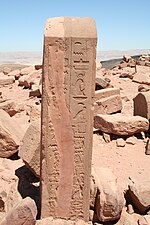


Serabit el-Khadim (Arabic: سرابيط الخادم Arabic pronunciation: [saraːˈbiːtˤ alˈxaːdɪm]; also transliterated Serabit al-Khadim, Serabit el-Khadem) is a locality in the southwest Sinai Peninsula, Egypt, where turquoise was mined extensively in antiquity, mainly by the ancient Egyptians. Archaeological excavation, initially by Sir Flinders Petrie, revealed ancient mining camps and a long-lived Temple of Hathor, the Egyptian goddess who was favoured as a protector in desert regions and known locally as the mistress of the turquoise. The temple was first established during the Middle Kingdom in the reign of Sesostris I (reigned 1971 BC to 1926 BC) and was partly reconstructed in the New Kingdom.[1]

Thirty incised graffiti in a "Proto-Sinaitic script" shed light on the history of the alphabet.[2] The mines were worked by prisoners of war from southwest Asia who presumably spoke a Northwest Semitic language, such as the Canaanite that was ancestral to Phoenician and Hebrew. The incisions date from the beginning of the 16th century BC.[3]
| International |
|
|---|---|
| National |
|
| Geographic |
|
29°2′12″N 33°27′33″E / 29.03667°N 33.45917°E / 29.03667; 33.45917